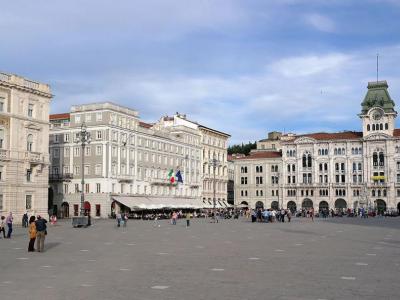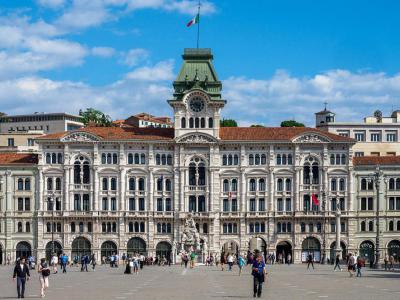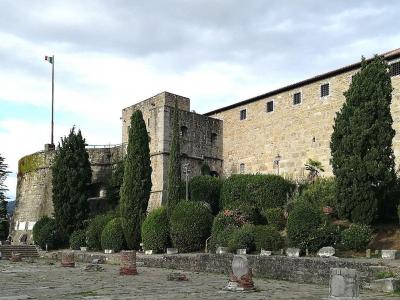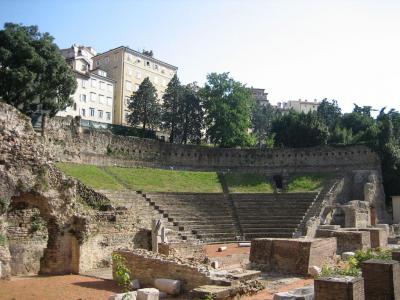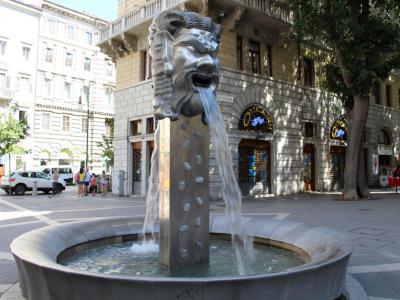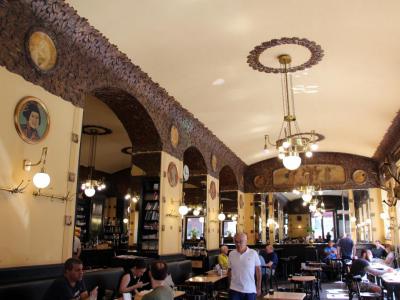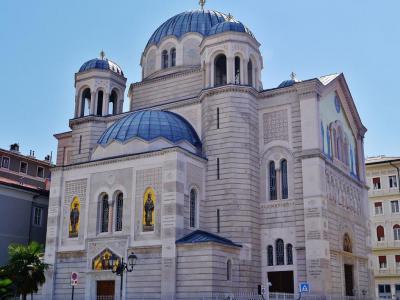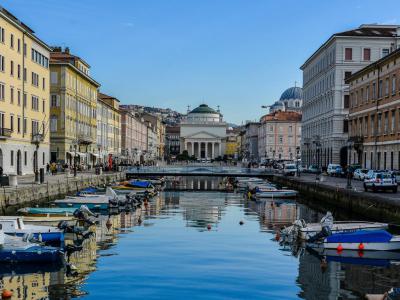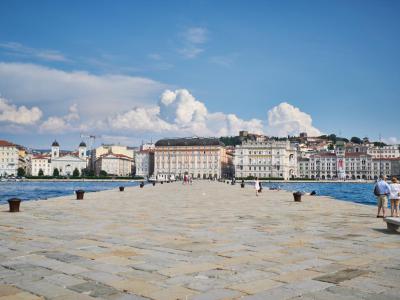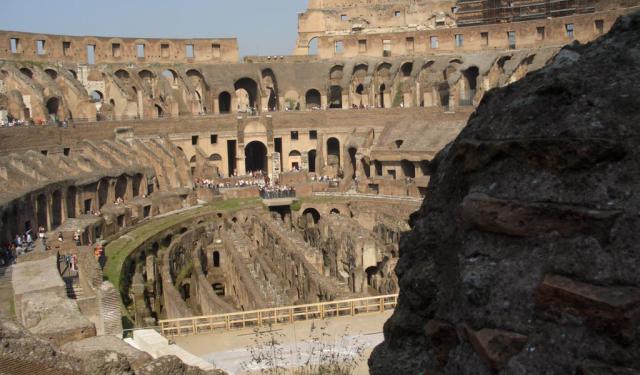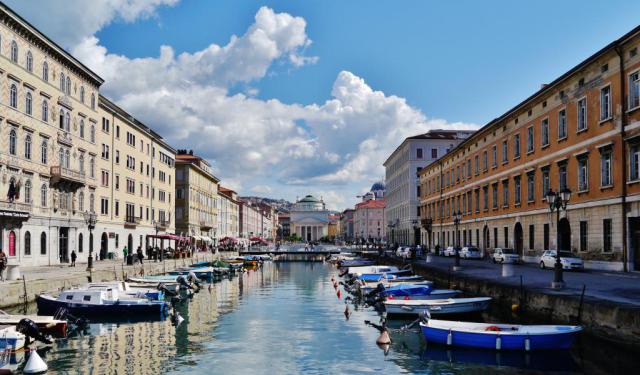
Trieste Introduction Walking Tour (Self Guided), Trieste
Sub-tropical Trieste lies on a bit of land between the Adriatic Sea and Slovenia. Savannas, forests, and karstic areas of sinkholes and caves surround the coastline. It is a deep-water port and a major gateway to northern Italy. It is called "Vienna by the Sea" by some or "City of Coffee" by others.
The ancient Veneti tribes called the town "Tergeste," which means "Market." Julius Caesar mentions Tergeste in his "Gallic Wars." Augustus built city walls, and Trajan built a theatre. The Barcola area of town provided a refuge for wealthy Romans from the dreaded winds of the Bora.
Trieste was the main port of the Austro-Hungarian Empire for over 500 years. The imperial monarchy left its impression. The old city center is mainly pedestrianized and easy to explore. Passions to be explored in Trieste are art, history, architecture, the seashore, shopping, and Viennese-style coffee houses.
The atmospheric Cafe San Marco, founded in 1914, was a hangout for James Joyce and other writers, and it has its own bookshop. Cafe Tommase, established in 1825, is the oldest cafe in town. Chocolate pralines, pastries, croissants, and strudel can be had at the Paticceria La Bomboniera.
The Unity of Italy Square is a major attraction, open on the seashore and lined on three sides by the Hapsburg City Hall, the Lloyd's Palace (Palazzo del Lloyd), the gold and mosaic Palace of the Prefecture (Palazzo della Prefettura) and the Fountain of the Four Continents.
Stroll down the Grand Canal with its bridges and palaces to the neoclassical Church of Saint Antonio Taumaturgo. See the blue domes of the Church of San Spyridon from the Red Bridge (Ponte Rosso). In December, there is a unique Christmas market with stalls and kiosks around the canal and side streets.
Climb up to San Giusto Hill. Visit the Castle of San Giusto and the 13th-century San Giusto Cathedral. Don't miss the sunset from the Bold Wharf (Molo Audace), projecting over 800 feet into the sea. Visit museums in palaces, exotic parks, and gardens. Come and see why emperors and princes have enjoyed Trieste.
The ancient Veneti tribes called the town "Tergeste," which means "Market." Julius Caesar mentions Tergeste in his "Gallic Wars." Augustus built city walls, and Trajan built a theatre. The Barcola area of town provided a refuge for wealthy Romans from the dreaded winds of the Bora.
Trieste was the main port of the Austro-Hungarian Empire for over 500 years. The imperial monarchy left its impression. The old city center is mainly pedestrianized and easy to explore. Passions to be explored in Trieste are art, history, architecture, the seashore, shopping, and Viennese-style coffee houses.
The atmospheric Cafe San Marco, founded in 1914, was a hangout for James Joyce and other writers, and it has its own bookshop. Cafe Tommase, established in 1825, is the oldest cafe in town. Chocolate pralines, pastries, croissants, and strudel can be had at the Paticceria La Bomboniera.
The Unity of Italy Square is a major attraction, open on the seashore and lined on three sides by the Hapsburg City Hall, the Lloyd's Palace (Palazzo del Lloyd), the gold and mosaic Palace of the Prefecture (Palazzo della Prefettura) and the Fountain of the Four Continents.
Stroll down the Grand Canal with its bridges and palaces to the neoclassical Church of Saint Antonio Taumaturgo. See the blue domes of the Church of San Spyridon from the Red Bridge (Ponte Rosso). In December, there is a unique Christmas market with stalls and kiosks around the canal and side streets.
Climb up to San Giusto Hill. Visit the Castle of San Giusto and the 13th-century San Giusto Cathedral. Don't miss the sunset from the Bold Wharf (Molo Audace), projecting over 800 feet into the sea. Visit museums in palaces, exotic parks, and gardens. Come and see why emperors and princes have enjoyed Trieste.
How it works: Download the app "GPSmyCity: Walks in 1K+ Cities" from Apple App Store or Google Play Store to your mobile phone or tablet. The app turns your mobile device into a personal tour guide and its built-in GPS navigation functions guide you from one tour stop to next. The app works offline, so no data plan is needed when traveling abroad.
Trieste Introduction Walking Tour Map
Guide Name: Trieste Introduction Walking Tour
Guide Location: Italy » Trieste (See other walking tours in Trieste)
Guide Type: Self-guided Walking Tour (Sightseeing)
# of Attractions: 13
Tour Duration: 2 Hour(s)
Travel Distance: 3.7 Km or 2.3 Miles
Author: nataly
Sight(s) Featured in This Guide:
Guide Location: Italy » Trieste (See other walking tours in Trieste)
Guide Type: Self-guided Walking Tour (Sightseeing)
# of Attractions: 13
Tour Duration: 2 Hour(s)
Travel Distance: 3.7 Km or 2.3 Miles
Author: nataly
Sight(s) Featured in This Guide:
- Piazza Unità d'Italia (Unity of Italy Square)
- Palazzo del Municipio (City Hall)
- Cattedrale di San Giusto (Trieste Cathedral)
- Castello di San Giusto (Castle of San Giusto)
- Teatro Romano di Trieste (Roman Theatre of Trieste)
- Viale XX Settembre (September 20th Avenue)
- Caffe San Marco
- Tempio Israelitico di Trieste (Synagogue of Trieste)
- Chiesa di Sant'Antonio Taumaturgo (Church of Saint Antonio Taumaturgo)
- Chiesa Serbo Ortodossa di San Spiridione (Saint Spyridon Church)
- Canal Grande (Grand Canal)
- Chiesa Greco-Ortodossa di San Nicolo (Greek Orthodox Church of San Nicolo)
- Molo Audace (Bold Wharf)
1) Piazza Unità d'Italia (Unity of Italy Square) (must see)
The Unity of Italy Square in Trieste is today the largest sea-facing square in Europe. Located at the base of the hill of the castle San Giusto, it was once the most important seaport of the Austro-Hungarian Empire.
Originally it was Saint Peter Square (Piazza San Pietro). The indigenous Slovenes called it Great or Grand Square. Then the name was changed to Francesco Giuseppe, after Emperor Franz Joseph. In 1918, it became Unity Square (Piazza Unita) in honor of Trieste's annexation by Italy. On April 15, 1955, it was awarded the name Unity of Italy Square (Piazza Unita d'Italia).
The vast, elegant square opens on the Gulf of Trieste. It is lined on three sides by lavish Viennese-type government buildings. Leading off the square are the ancient meandering streets of the venerable Roman settlement of Trieste. The grid-fashioned Borgo Teresiano district is also an adjunct to the noted place.
The City Hall (Palazzo del Municipio), with its clock tower and bronze Moors, faces the sea. The imposing Lloyd Triestino Palace and the Government Palace (Palazzo del Governo) are on the sides. The building has a golden mosaic facade. The Fountain of the Four Continents, built between 1751 and 1754 by the sculptor Giovanni Battista Mazzoleni, stands in front of the City Hall. A lighting system with blue LEDs was installed to emphasize the connection with the sea.
The square has served well as a concert venue. The Green Day rock group performed there in 2013 with their show, "99 Revolutions." Some 12,000 people attended. The heavy metal group, Iron Maiden, performed, drawing as many as 15,000 enthusiastic fans.
Foreign heads of state have met in the square. Russian President Vladimir Putin and Italian PM Enrico Letta met here in 2013. In 2017, a trilateral meeting attended by Angela Merkel, Emmanuel Macron, and Paolo Gentiloni was held there, as well as the fourth Western Balkans Summit.
Merchants, sailors, artists, visitors, and heads of state have called the square the "Front Parlor" of Trieste, and with good reason. It is a great place to enjoy a coffee on a Sunday and watch the sunset as children play and families stroll along the waterfront.
Originally it was Saint Peter Square (Piazza San Pietro). The indigenous Slovenes called it Great or Grand Square. Then the name was changed to Francesco Giuseppe, after Emperor Franz Joseph. In 1918, it became Unity Square (Piazza Unita) in honor of Trieste's annexation by Italy. On April 15, 1955, it was awarded the name Unity of Italy Square (Piazza Unita d'Italia).
The vast, elegant square opens on the Gulf of Trieste. It is lined on three sides by lavish Viennese-type government buildings. Leading off the square are the ancient meandering streets of the venerable Roman settlement of Trieste. The grid-fashioned Borgo Teresiano district is also an adjunct to the noted place.
The City Hall (Palazzo del Municipio), with its clock tower and bronze Moors, faces the sea. The imposing Lloyd Triestino Palace and the Government Palace (Palazzo del Governo) are on the sides. The building has a golden mosaic facade. The Fountain of the Four Continents, built between 1751 and 1754 by the sculptor Giovanni Battista Mazzoleni, stands in front of the City Hall. A lighting system with blue LEDs was installed to emphasize the connection with the sea.
The square has served well as a concert venue. The Green Day rock group performed there in 2013 with their show, "99 Revolutions." Some 12,000 people attended. The heavy metal group, Iron Maiden, performed, drawing as many as 15,000 enthusiastic fans.
Foreign heads of state have met in the square. Russian President Vladimir Putin and Italian PM Enrico Letta met here in 2013. In 2017, a trilateral meeting attended by Angela Merkel, Emmanuel Macron, and Paolo Gentiloni was held there, as well as the fourth Western Balkans Summit.
Merchants, sailors, artists, visitors, and heads of state have called the square the "Front Parlor" of Trieste, and with good reason. It is a great place to enjoy a coffee on a Sunday and watch the sunset as children play and families stroll along the waterfront.
2) Palazzo del Municipio (City Hall)
Located in the Square of Italian Unity, the City Hall is the seat of the Municipality of Trieste. In the late 19th century, the old Palace of the Magistrate was demolished to make way for the new municipal building. Trieste architect Giuseppe Bruni, who had formerly designed the Modello Palace, was chosen for the City Hall.
Engineer and architect Eugenio Geiringer was the director of the project, which was completed in 1875. The facade, facing the square, is Eclectic in style. It has two side bodies of four floors and a central body of five. The grand floor has portico or gallery-like arches. Upper floors have mullioned windows.
In the center, atop the clock tower, two bronze statues of Moors, nicknamed "Micheze" and "Jacheze" (from Slovenian Mihec and Jakec), guard the bell. Giuseppe Bruni installed the Moors. They are in memory of the two who struck the chimes on the Mandracchio Tower, the former Gateway to the port, demolished in 1838.
The original Moors, sculpted by Fausto Asteo da Ceneda, were installed in January 1876. They were replaced by copies in 1972 while being restored. In 2004 the refurbished statues were set up at the entrance of San Giusto Castle.
On a stage in front of the building in 1938, the dictator Benito Mussolini announced his hateful racial laws. This disaster was corrected in 1954 as the mayor of the city, Gianni Bartoli, announced celebrations marking the return of Trieste to Italy.
Engineer and architect Eugenio Geiringer was the director of the project, which was completed in 1875. The facade, facing the square, is Eclectic in style. It has two side bodies of four floors and a central body of five. The grand floor has portico or gallery-like arches. Upper floors have mullioned windows.
In the center, atop the clock tower, two bronze statues of Moors, nicknamed "Micheze" and "Jacheze" (from Slovenian Mihec and Jakec), guard the bell. Giuseppe Bruni installed the Moors. They are in memory of the two who struck the chimes on the Mandracchio Tower, the former Gateway to the port, demolished in 1838.
The original Moors, sculpted by Fausto Asteo da Ceneda, were installed in January 1876. They were replaced by copies in 1972 while being restored. In 2004 the refurbished statues were set up at the entrance of San Giusto Castle.
On a stage in front of the building in 1938, the dictator Benito Mussolini announced his hateful racial laws. This disaster was corrected in 1954 as the mayor of the city, Gianni Bartoli, announced celebrations marking the return of Trieste to Italy.
3) Cattedrale di San Giusto (Trieste Cathedral) (must see)
The first Christian edifice, on the Cathedral of Saint Justus (Cattedrale di San Giusto) site, was built in the 6th century. Before that, a Capitoline Temple was here. A pyramidal altar with symbols of Jupiter, Juno, and Minerva, Roman gods, has been uncovered inside it. The temple had a propylaeum, an entrance gateway to the spiritual realm.
The Christian church used parts of the earlier pagan temple, including the propylaeum. The original remains of the mosaic floor were integrated into the present-day floor, which contains elements of the outer walls of the previous structure. Shortly after the church was opened, it was destroyed by invading Lombards.
Sometime between the 9th and 11th centuries, two basilicas were built over the remains of the first church. Our Lady of the Assumption was joined to Saint Justus in the 14th century by demolishing the facing naves of each building and attaching a slightly asymmetrical Romanesque facade. An elegant Gothic rose window adorns the exterior.
The stolid-looking bell tower absorbed the Roman propylaeum. The bell tower niche contains a 14th-century sculpture of Saint Justus. He is holding the palm of martyrdom and a model of the city under his protection. The interior has one nave and four aisles. The two apses are finished with fine Byzantine-Ravenna mosaics.
The chapel of Saint Charles Borromeo holds nine tombs of Carlist claimants to the Spanish throne. The Chapel of the Treasure has the reliquary urn of Saint Justus, the Crucifix, and the halberd of Saint Sergius. Some say the weapon fell from the sky when Saint Sergius was martyred.
Artworks within the cathedral include 12th-century mosaics in the apses dedicated to Our Lady of the Assumption and Christ, Saints Justus, and Servolus. The medieval churchyard holds the small 14th-century Church of Saint John on one side and Saint Michael on the other.
The Christian church used parts of the earlier pagan temple, including the propylaeum. The original remains of the mosaic floor were integrated into the present-day floor, which contains elements of the outer walls of the previous structure. Shortly after the church was opened, it was destroyed by invading Lombards.
Sometime between the 9th and 11th centuries, two basilicas were built over the remains of the first church. Our Lady of the Assumption was joined to Saint Justus in the 14th century by demolishing the facing naves of each building and attaching a slightly asymmetrical Romanesque facade. An elegant Gothic rose window adorns the exterior.
The stolid-looking bell tower absorbed the Roman propylaeum. The bell tower niche contains a 14th-century sculpture of Saint Justus. He is holding the palm of martyrdom and a model of the city under his protection. The interior has one nave and four aisles. The two apses are finished with fine Byzantine-Ravenna mosaics.
The chapel of Saint Charles Borromeo holds nine tombs of Carlist claimants to the Spanish throne. The Chapel of the Treasure has the reliquary urn of Saint Justus, the Crucifix, and the halberd of Saint Sergius. Some say the weapon fell from the sky when Saint Sergius was martyred.
Artworks within the cathedral include 12th-century mosaics in the apses dedicated to Our Lady of the Assumption and Christ, Saints Justus, and Servolus. The medieval churchyard holds the small 14th-century Church of Saint John on one side and Saint Michael on the other.
4) Castello di San Giusto (Castle of San Giusto)
The Castle of San Giusto (Castello di San Giusto) sits on the Hill of San Giusto, overlooking the city. By 1382, Trieste was exhausted by the never-ending battles with the Venetians. In 1381, they signed an act with Leopold III of Austria aptly called the "Spontaneous Surrender to Austria." The city would be independent under an Austrian Imperial Captain.
In 1468, Frederick III, Holy Roman Emperor, ordered the construction of a fortress to protect the town and provide accommodation for its Captain. Frederick had ruthlessly sacked the city driving out the persistent Venetians. He also made the fourth restoration of the city walls, just in time to avoid another sacking by the Ottomans in 1470.
The fortress can be entered by crossing a small drawbridge. At the entrance are several escutcheons and military banners of patrician families of the city. A left corridor leads to the old defensive firing positions. The right-hand passage accesses the weapons museum and the guardhouse.
A staircase leads to the vast terrace and the parade ground. There are stands in the courtyard offering spectacular views of the city below. Visitors are permitted in the Captain's House, the San Giorgio Chapel, and the luxurious Venetian Room (Sala Veneta). The weapons collection dates from the 12th century.
At the entrance are the two original statues of "Micheze" and "Jacheze," the two bronze Moors who once marked the hours on the Town Hall clock tower.
In 1468, Frederick III, Holy Roman Emperor, ordered the construction of a fortress to protect the town and provide accommodation for its Captain. Frederick had ruthlessly sacked the city driving out the persistent Venetians. He also made the fourth restoration of the city walls, just in time to avoid another sacking by the Ottomans in 1470.
The fortress can be entered by crossing a small drawbridge. At the entrance are several escutcheons and military banners of patrician families of the city. A left corridor leads to the old defensive firing positions. The right-hand passage accesses the weapons museum and the guardhouse.
A staircase leads to the vast terrace and the parade ground. There are stands in the courtyard offering spectacular views of the city below. Visitors are permitted in the Captain's House, the San Giorgio Chapel, and the luxurious Venetian Room (Sala Veneta). The weapons collection dates from the 12th century.
At the entrance are the two original statues of "Micheze" and "Jacheze," the two bronze Moors who once marked the hours on the Town Hall clock tower.
5) Teatro Romano di Trieste (Roman Theatre of Trieste)
At the foot of San Giusto Hill is the long-buried, now-exposed Roman Theatre of old Trieste. It is an amphitheater cut into the hillside in an ancient Greek fashion. It dates from the first and second century AD. It could hold up to 6,000 theatre-goers. Its construction was nearly all masonry except for the wooden stage.
In 1814, archeologist Pietro Nobile intuited the presence of a theatre from the name of a village. The name was Old Arena (Rena Vecia). The amphitheater was brought to light only in 1938 following major urban reconstructions. The ornamental plaques and statues discovered in the theatre are now in the Civic Museum of History and Art (Orto Lapidario).
In its heyday, in the 1st century, the theatre was outside the city walls, at the water's edge. The theatre was enlarged during the reign of Trajan in the 2nd century by Quinto Petronio Modesto, the imperial procurator. The seating area on the slope of the hill is divided into four sections by sets of steps, levels, and corridors.
Attilio Tamaro, historian and journalist, also intuited the reality of the Roman Theatre. In his History of Trieste (Storia di Trieste), he wrote: "A real monument will emerge one day in the Trieste sky." He claimed entire floors were entombed under the houses of the Old Arena neighborhood. Like Pietro Nobile, he was right.
In 1814, archeologist Pietro Nobile intuited the presence of a theatre from the name of a village. The name was Old Arena (Rena Vecia). The amphitheater was brought to light only in 1938 following major urban reconstructions. The ornamental plaques and statues discovered in the theatre are now in the Civic Museum of History and Art (Orto Lapidario).
In its heyday, in the 1st century, the theatre was outside the city walls, at the water's edge. The theatre was enlarged during the reign of Trajan in the 2nd century by Quinto Petronio Modesto, the imperial procurator. The seating area on the slope of the hill is divided into four sections by sets of steps, levels, and corridors.
Attilio Tamaro, historian and journalist, also intuited the reality of the Roman Theatre. In his History of Trieste (Storia di Trieste), he wrote: "A real monument will emerge one day in the Trieste sky." He claimed entire floors were entombed under the houses of the Old Arena neighborhood. Like Pietro Nobile, he was right.
6) Viale XX Settembre (September 20th Avenue)
Saint Nicholas has his traditional December festival on XX September Avenue (Viale XX Settembre ) in Trieste. From 9 am to 9 pm, 86 or more stalls offer food, toys, and gifts. The site is a haven of peace compared to the chaotically busy Battista Street. The XX September Avenue, built over the city's ancient aqueduct, is mainly pedestrianized and tree-lined.
The XX September Avenue links with Carducci Street and the Il Giulia shopping center. Some of the city's best cinemas are located here. There is the Excelsior, the National Cinema (Cinema Nazionale), the Super, and the Mignon (a vintage adult cinema). The Ambassadors Cinema (Cinema Ambasciatori) is housed in one of the most important Art Nouveau buildings in the city center. The Rossetti theatre is located on the street.
Gelaterias, pizzerias, patisseries, and fine restaurants and shops are easy to find. The avenue has always been a favorite ad hoc institution. Over one kilometer long, it stretches over three of the seven municipal districts of the city.
The XX September Avenue is named in honor of the so-called Breaking of the Pia Gate (Breccia di Porta Pia). In September 1870, the Bersaglieri troops, under General Cadona, entered the Eternal City and seized a section of the Aurelian Wall between Porta Pia Gate and Salaria Gate. The Pope agreed to a referendum, and the Romans voted for Italy.
The XX September Avenue links with Carducci Street and the Il Giulia shopping center. Some of the city's best cinemas are located here. There is the Excelsior, the National Cinema (Cinema Nazionale), the Super, and the Mignon (a vintage adult cinema). The Ambassadors Cinema (Cinema Ambasciatori) is housed in one of the most important Art Nouveau buildings in the city center. The Rossetti theatre is located on the street.
Gelaterias, pizzerias, patisseries, and fine restaurants and shops are easy to find. The avenue has always been a favorite ad hoc institution. Over one kilometer long, it stretches over three of the seven municipal districts of the city.
The XX September Avenue is named in honor of the so-called Breaking of the Pia Gate (Breccia di Porta Pia). In September 1870, the Bersaglieri troops, under General Cadona, entered the Eternal City and seized a section of the Aurelian Wall between Porta Pia Gate and Salaria Gate. The Pope agreed to a referendum, and the Romans voted for Italy.
7) Caffe San Marco
The historic Caffe San Marco opened for business in Trieste in 1914. It is still located on Battista Street and is still the property of Italy's largest insurance company, General Insurance (Assicurazioni Generali). It soon became an emblematic watering hole for the city's writers, artists, students, musicians, and activists known as the "irredentists."
Among well-known regulars were intellectuals and writers James Joyce, Italo Svevo, Umberto Saba, Giani Stuparich, and Virgilio Giotti. The cafe was destroyed in the first World War by the Austrian troops, but it re-opened almost immediately afterward.
Entering the Caffe San Marco, one is enveloped in an atmosphere of liberty and Bohemia. The brass lamps hanging from the high ceilings, the Veronese red marble tables, and the mirrors on the walls reflecting original paintings give rise to emotions accompanied by the marvelous aroma of fresh ground coffee.
The interior reflects the Art Nouveau aspects of the Vienna Secession style of buildings so popular in the late 19th and early 20th centuries. As well as original art, the walls have frescoes credited to the famous Secessionist artist Vito Timmel. The cafe was thoroughly restored in 2013 and now has a small bookstore that also functions as a cultural core, hosting book presentations and discussions with writers, actors, and artists.
Among well-known regulars were intellectuals and writers James Joyce, Italo Svevo, Umberto Saba, Giani Stuparich, and Virgilio Giotti. The cafe was destroyed in the first World War by the Austrian troops, but it re-opened almost immediately afterward.
Entering the Caffe San Marco, one is enveloped in an atmosphere of liberty and Bohemia. The brass lamps hanging from the high ceilings, the Veronese red marble tables, and the mirrors on the walls reflecting original paintings give rise to emotions accompanied by the marvelous aroma of fresh ground coffee.
The interior reflects the Art Nouveau aspects of the Vienna Secession style of buildings so popular in the late 19th and early 20th centuries. As well as original art, the walls have frescoes credited to the famous Secessionist artist Vito Timmel. The cafe was thoroughly restored in 2013 and now has a small bookstore that also functions as a cultural core, hosting book presentations and discussions with writers, actors, and artists.
8) Tempio Israelitico di Trieste (Synagogue of Trieste)
During the Austrian regime in Trieste, between 1908 and 1912, architect Ruggero Berlam and his son, Arduino, designed the massive Synagogue of Trieste. Unveiled in 1912, the Synagogue replaced four smaller 18th-century synagogues called "Scholae."
The architectural style was common in Northeastern Italy. Size and structure indicate a synagogue of the so-called "emancipation period." A rectangular prayer room has three naves and a magnificent apse with golden mosaics.
The focus is on the Aron Kodesh, an altar cabinet with copper doors storing the Torah scrolls. A pink granite aedicule (a small structure used as a shrine) protects the Tables of the Law with four columns. The aedicule is flanked by two large menorahs (candelabras with seven branches). The menorah is leaning on a marble balustrade with a sheaf of wheat, symbolizing the Jewish community of Trieste.
On the ceiling, ornate pendants edge the dome in floral designs and geometrical patterns. Above the Aron, on three sides, is the women's balcony, no longer used. In the gallery, under the barrel vault, is an impressive pipe organ with pipes set off with stars of David.
The exterior style is Romanesque, found in 4th-century Syria. The architects Ruggero and Arduino Berlam felt it was closer to ancient Jewish architecture. It could represent the Middle Eastern Jewish origins without being too Byzantine or Muslim.
During the Fascist regime, the temple was used to store artworks stolen from Jewish homes. The ritual silvers of the Jewish Community have been saved by hiding them within the temple. At the end of the war, the Synagogue went back into operation. Today it is one of the largest and most important places of worship for Jews in Europe.
The architectural style was common in Northeastern Italy. Size and structure indicate a synagogue of the so-called "emancipation period." A rectangular prayer room has three naves and a magnificent apse with golden mosaics.
The focus is on the Aron Kodesh, an altar cabinet with copper doors storing the Torah scrolls. A pink granite aedicule (a small structure used as a shrine) protects the Tables of the Law with four columns. The aedicule is flanked by two large menorahs (candelabras with seven branches). The menorah is leaning on a marble balustrade with a sheaf of wheat, symbolizing the Jewish community of Trieste.
On the ceiling, ornate pendants edge the dome in floral designs and geometrical patterns. Above the Aron, on three sides, is the women's balcony, no longer used. In the gallery, under the barrel vault, is an impressive pipe organ with pipes set off with stars of David.
The exterior style is Romanesque, found in 4th-century Syria. The architects Ruggero and Arduino Berlam felt it was closer to ancient Jewish architecture. It could represent the Middle Eastern Jewish origins without being too Byzantine or Muslim.
During the Fascist regime, the temple was used to store artworks stolen from Jewish homes. The ritual silvers of the Jewish Community have been saved by hiding them within the temple. At the end of the war, the Synagogue went back into operation. Today it is one of the largest and most important places of worship for Jews in Europe.
9) Chiesa di Sant'Antonio Taumaturgo (Church of Saint Antonio Taumaturgo)
The Church of Sant'Antonio Taumaturgo ("Miracle Worker") is the largest Catholic Church in Trieste. The church, dedicated to Saint Anthony of Padua, is located on the huge Sant'Antonio Nuovo Square, facing the Grand Canal.
The first church at this location before the middle of the 18th century was a private chapel dedicated to the Annunciation. It was too small to accommodate worshipers. It was soon replaced by a new church named Sant'Antonio Nuovo. Completed in 1771, the new church also proved too small. A competition to design a new church was held in 1808.
Neoclassicist architect Pietro Nobile won the competition. Work was slow, and the church was not completed until consecration in 1849. The facade holds an imperial-looking portico with six Ionic columns and a massive unadorned pediment.
On the main facade are six statues of the patron saints of Trieste, Saint Giusto, Saint Sergio, Saint Servolo, Saint Muro, Saint Eufemia, and Saint Tecla, sculpted by Francesco Bosa. The rear facade has twin bell towers. The enormous interior features barrel arches and vaults. In the apse is a fresco of Jesus Entering Jerusalem by Sebastiano Santi.
Six lateral niches hold altarpieces showing Saint Anna and the Virgin Child, by Michelangelo Grigoletti; The Presentation, by Felice Schiavoni; Saint Anthony in Glory by Odorico Politi; the Martyrdom of Saints Euphemia, Erasma, Tecla, and Dorotea by Ludovico Lipparini; and the Crucifixion by Joseph Ernest Tunner.
The first church at this location before the middle of the 18th century was a private chapel dedicated to the Annunciation. It was too small to accommodate worshipers. It was soon replaced by a new church named Sant'Antonio Nuovo. Completed in 1771, the new church also proved too small. A competition to design a new church was held in 1808.
Neoclassicist architect Pietro Nobile won the competition. Work was slow, and the church was not completed until consecration in 1849. The facade holds an imperial-looking portico with six Ionic columns and a massive unadorned pediment.
On the main facade are six statues of the patron saints of Trieste, Saint Giusto, Saint Sergio, Saint Servolo, Saint Muro, Saint Eufemia, and Saint Tecla, sculpted by Francesco Bosa. The rear facade has twin bell towers. The enormous interior features barrel arches and vaults. In the apse is a fresco of Jesus Entering Jerusalem by Sebastiano Santi.
Six lateral niches hold altarpieces showing Saint Anna and the Virgin Child, by Michelangelo Grigoletti; The Presentation, by Felice Schiavoni; Saint Anthony in Glory by Odorico Politi; the Martyrdom of Saints Euphemia, Erasma, Tecla, and Dorotea by Ludovico Lipparini; and the Crucifixion by Joseph Ernest Tunner.
10) Chiesa Serbo Ortodossa di San Spiridione (Saint Spyridon Church)
Saint Spyridon, a Serbian Orthodox Church in Trieste, dates from 1751. Empress Maria Theresa of Austria had received a visit from Damaskinos Omiros, a Greek monk from Mount Athos. After that, she allowed the freedom of religion for Orthodox Christians. Thanks to Brother Damaskinos, the first Eastern Orthodox Church was built in the mid-18th century, and it served as a place of worship for both local Serbs and Greeks.
In 1858, the Serbian community in Trieste announced a competition to design a new Church of Saint Spyridon. Architects from Vienna, Venice, Milan, Munich, Rome, and Florence competed. Carlo Maciachini, the architect of Milan, was selected. Maciachini was known to favor "historical styles." He designed many Romanesque-Gothic buildings.
The construction was directed by engineer Pietro Palese of Trieste. The church is Byzantine. It has a Greek Cross plan covered by a high dome with four pendentives. Over the corners of the vast central hall are four smaller domes. The main facade is Italian-Romanesque. The effect is of a monumental, majestic temple.
The exterior is covered in stone quarried from Santa Croce and Istria. The use of mosaics is limited to the exterior facades. A mosaic on a golden background above the main entrance shows Saint Spyridon. The lunette and the niches above the north entrance have mosaics of Archangel Michael, Saint Athanasius, and Saint Gregory of Nazianzus.
In the interior above the altar is a painting of the Enthroned Christ with the Apostles. The Assumption is shown on the right. On the left is the Council of Nicaea in 325 AD. On the west wall is a picture of the sarcophagus of Spyridon in Korfu.
In the iconostasis are four icons of silver and gold and precious stones. Saint Spyridon, the Virgin Mary with Baby Jesus, Christ the King, and the Annunciation are represented. Above are Serbian Orthodox Saints Simeon, Sava, and Stephen. Uppermost is the Crucifixion, Resurrection, and Baptism of Christ.
In 1858, the Serbian community in Trieste announced a competition to design a new Church of Saint Spyridon. Architects from Vienna, Venice, Milan, Munich, Rome, and Florence competed. Carlo Maciachini, the architect of Milan, was selected. Maciachini was known to favor "historical styles." He designed many Romanesque-Gothic buildings.
The construction was directed by engineer Pietro Palese of Trieste. The church is Byzantine. It has a Greek Cross plan covered by a high dome with four pendentives. Over the corners of the vast central hall are four smaller domes. The main facade is Italian-Romanesque. The effect is of a monumental, majestic temple.
The exterior is covered in stone quarried from Santa Croce and Istria. The use of mosaics is limited to the exterior facades. A mosaic on a golden background above the main entrance shows Saint Spyridon. The lunette and the niches above the north entrance have mosaics of Archangel Michael, Saint Athanasius, and Saint Gregory of Nazianzus.
In the interior above the altar is a painting of the Enthroned Christ with the Apostles. The Assumption is shown on the right. On the left is the Council of Nicaea in 325 AD. On the west wall is a picture of the sarcophagus of Spyridon in Korfu.
In the iconostasis are four icons of silver and gold and precious stones. Saint Spyridon, the Virgin Mary with Baby Jesus, Christ the King, and the Annunciation are represented. Above are Serbian Orthodox Saints Simeon, Sava, and Stephen. Uppermost is the Crucifixion, Resurrection, and Baptism of Christ.
11) Canal Grande (Grand Canal) (must see)
The Grand Canal of Trieste is short but navigable. It is located in the Borgo Teresiano neighborhood, between the railway station and the Unity of Italy Square (Piazza Unita d'Italia). It was built between 1754 and 1756 by Venetian engineer Matteo Pirona. Initially, the canal reached all the way to the front of the Church Sant'Antonio Taumaturgo.
The Grand Canal had access to the Gulf of Trieste, allowing ships and barges to load and unload in the city's center. The last section of the canal touching the front of the church was filled in with rubble in 1934, creating the Sant'Antonio Nuovo Square. Some say a small torpedo boat is buried there, but no one wants to dig it up.
Two bridges and a pedestrian walkway traverse the Grand Canal. Red Bridge (Ponte Rosso) crosses at the mid-point of the canal. Built-in wood in 1756, it was done in iron in 1832. Green Bridge (Ponte Verde), at the beginning of the canal, was built in iron in 1858. In 1904 the White Bridge, known as New Bridge (Ponte Nuovo), was added as a railway bridge.
The 82-foot-long walkway connecting Saving Bank Street (Via Cassa di Risparmio ) to Trento Street crossed the canal on December 4, 2012. It is steel with glass parapets and handrails. Officially it was called Joyce Passage (Passagio Joyce), in honor of Irish writer James Joyce. Joyce's statue by sculptor Nino Spagnoli was erected on the Red Bridge in 2004.
Christmas markets and the Barcolana regatta are held along the canal and the Sant'Antonio Square.
The Grand Canal had access to the Gulf of Trieste, allowing ships and barges to load and unload in the city's center. The last section of the canal touching the front of the church was filled in with rubble in 1934, creating the Sant'Antonio Nuovo Square. Some say a small torpedo boat is buried there, but no one wants to dig it up.
Two bridges and a pedestrian walkway traverse the Grand Canal. Red Bridge (Ponte Rosso) crosses at the mid-point of the canal. Built-in wood in 1756, it was done in iron in 1832. Green Bridge (Ponte Verde), at the beginning of the canal, was built in iron in 1858. In 1904 the White Bridge, known as New Bridge (Ponte Nuovo), was added as a railway bridge.
The 82-foot-long walkway connecting Saving Bank Street (Via Cassa di Risparmio ) to Trento Street crossed the canal on December 4, 2012. It is steel with glass parapets and handrails. Officially it was called Joyce Passage (Passagio Joyce), in honor of Irish writer James Joyce. Joyce's statue by sculptor Nino Spagnoli was erected on the Red Bridge in 2004.
Christmas markets and the Barcolana regatta are held along the canal and the Sant'Antonio Square.
12) Chiesa Greco-Ortodossa di San Nicolo (Greek Orthodox Church of San Nicolo)
The Greek Orthodox Church of Saint Nicholas and the Holy Trinity was built on the seafront of Trieste in the 18th century. On August 2, 1782, the Greek Orthodox community was officially founded, and in 1784 began to build its church on the waterfront of the Old Port. The church, designed by architect Matteo Pertsch, was consecrated to San Nicolò (patron saint of sailors) and the Holy Trinity.
The building features Romanesque and Neoclassical architectural styles with a simple, plain facade topped with an unadorned triangular pediment. There are six full-length doric pilasters on the front. The church has twin square bell towers with balconies, a window, and a clock on each side.
Inside are marble floors, ornate chandeliers, a carved wooden pulpit, and an overwhelming crucifix. Icons and paintings are all over the walls and ceilings. Christ, the Virgin and Child, John the Baptist, other saints, and biblical scenes are depicted.
There are three liturgical areas. The presbytery has three apses, the bay, and two balconies for the gynaeceum (women's gallery) and the choir. The iconostasis splits the presbytery between priests and worshippers. The bay floor is of black and white marble. Saint Nicolo's candle-lit icon is in the center.
Christ in Glory, surrounded by an angelic host, covers the flat ceiling. The artist is unknown. Between the windows are figures of the Evangelists and Apostles. Cesare dell'Acqua's paintings The Sermon of John in the Dessert and Jesus Calling the Small Children to Him are on the side walls. Above the right door, Abraham is welcomed by angels.
The building features Romanesque and Neoclassical architectural styles with a simple, plain facade topped with an unadorned triangular pediment. There are six full-length doric pilasters on the front. The church has twin square bell towers with balconies, a window, and a clock on each side.
Inside are marble floors, ornate chandeliers, a carved wooden pulpit, and an overwhelming crucifix. Icons and paintings are all over the walls and ceilings. Christ, the Virgin and Child, John the Baptist, other saints, and biblical scenes are depicted.
There are three liturgical areas. The presbytery has three apses, the bay, and two balconies for the gynaeceum (women's gallery) and the choir. The iconostasis splits the presbytery between priests and worshippers. The bay floor is of black and white marble. Saint Nicolo's candle-lit icon is in the center.
Christ in Glory, surrounded by an angelic host, covers the flat ceiling. The artist is unknown. Between the windows are figures of the Evangelists and Apostles. Cesare dell'Acqua's paintings The Sermon of John in the Dessert and Jesus Calling the Small Children to Him are on the side walls. Above the right door, Abraham is welcomed by angels.
13) Molo Audace (Bold Wharf) (must see)
Some of the best views can be caught from the pier Bold Wharf (Molo Audace) in Trieste. Snow-capped mountains can be seen across the water. There is a view of the Unity of Italy Square (Piazza Unita d'Italia). Marine traffic on the pier is light. It is a magical place for a stroll and a breath of fresh air at any time of day and in any season.
In 1740, the ship San Carlo sank in Trieste harbor, quite close to the shore. Rather than removing the wreckage, it was decided to use the hulk as the basis of a shoreside pier. The pier was built and named the San Carlo Pier. At first, it measured 312 feet long and was attached to the shore by a small bridge.
By 1861 the pier had lengthened to 807 feet. The bridge was gone. The quay was attached firmly to the shore. The San Carlo pier was busy with the constant docking and undocking and the movement of people and goods.
In 1922 the pier was renamed Bold Wharf (Molo Audace) in honor of the destroyer Audace, the first ship of the Italian Navy to arrive in Trieste on November 3, 1918. The Audace's anchor is displayed at the Victory lighthouse today.
A bronze compass rose was erected on the pier in 1925. It bore the inscription "Cast in bronze enemy III November MCMXXV." The rose is supported by a white stone column with a plaque commemorating the restoration from damages of World War II.
In 1740, the ship San Carlo sank in Trieste harbor, quite close to the shore. Rather than removing the wreckage, it was decided to use the hulk as the basis of a shoreside pier. The pier was built and named the San Carlo Pier. At first, it measured 312 feet long and was attached to the shore by a small bridge.
By 1861 the pier had lengthened to 807 feet. The bridge was gone. The quay was attached firmly to the shore. The San Carlo pier was busy with the constant docking and undocking and the movement of people and goods.
In 1922 the pier was renamed Bold Wharf (Molo Audace) in honor of the destroyer Audace, the first ship of the Italian Navy to arrive in Trieste on November 3, 1918. The Audace's anchor is displayed at the Victory lighthouse today.
A bronze compass rose was erected on the pier in 1925. It bore the inscription "Cast in bronze enemy III November MCMXXV." The rose is supported by a white stone column with a plaque commemorating the restoration from damages of World War II.
Walking Tours in Trieste, Italy
Create Your Own Walk in Trieste
Creating your own self-guided walk in Trieste is easy and fun. Choose the city attractions that you want to see and a walk route map will be created just for you. You can even set your hotel as the start point of the walk.
Trieste's Ancient Roman Sites Walking Tour
The Roman remains on Trieste extend along the northwestern slope of San Giusto Hill, overlooking the Gulf of Trieste. Wharves of sandstone slabs dating from the 1st century AD were found by the Roman Theatre. The city walls, ordered by Augustus, were converted to use as terraces.
The Propylaeum of the 1st century AD was the gateway to the sacred area of the Capitoline Temple. There are two... view more
Tour Duration: 1 Hour(s)
Travel Distance: 0.9 Km or 0.6 Miles
The Propylaeum of the 1st century AD was the gateway to the sacred area of the Capitoline Temple. There are two... view more
Tour Duration: 1 Hour(s)
Travel Distance: 0.9 Km or 0.6 Miles
The Most Popular Cities
/ view all
